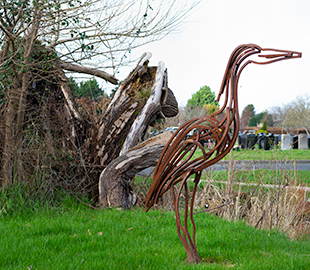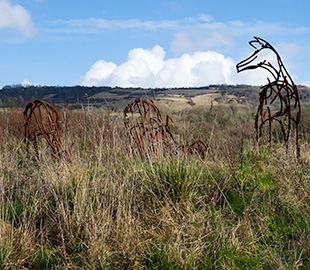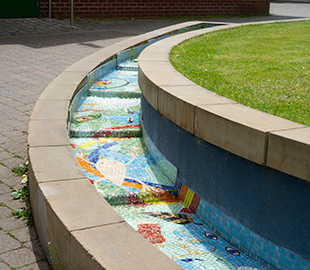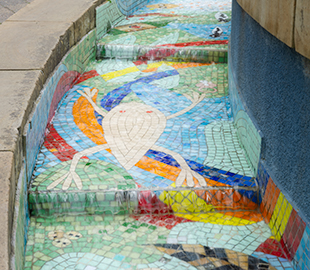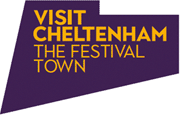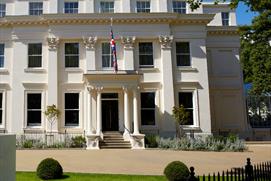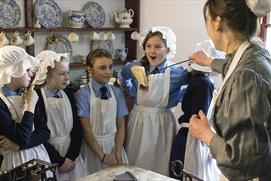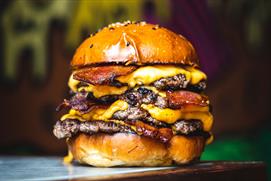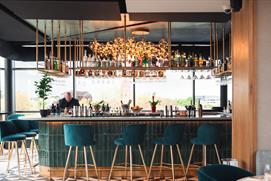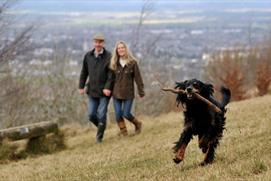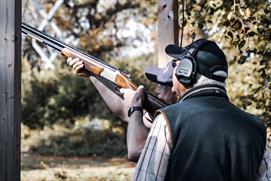Cheltenham Public Art Trail
The trail points
 Celluloid Ladies
Celluloid Ladies Barley
Barley Centre Stone
Centre Stone Boots Fountain
Boots Fountain Elephant Mosaics
Elephant Mosaics Wishing Clock
Wishing Clock Theme & Variations
Theme & Variations Sylphs with Trumpets
Sylphs with Trumpets Shakespeare
Shakespeare The Wilson Grille
The Wilson Grille Smiths Clock
Smiths Clock Phoenix
Phoenix Minotaur & Hare
Minotaur & Hare Phone Boxes
Phone Boxes Pigeons
Pigeons Neptunes Fountain
Neptunes Fountain Edward WIlson
Edward WIlson Boer War Memorial
Boer War Memorial Holst Statue
Holst Statue Imperial Fountain
Imperial Fountain Crimean War Memorial
Crimean War Memorial William IV Statue
William IV Statue Jubilee Seat
Jubilee Seat Playground Lion
Playground Lion Rotunda Lion
Rotunda Lion Caryatids
Caryatids Edward VII
Edward VII The Gordon Lamp
The Gordon Lamp Poppy
Poppy One Bayshill Bench
One Bayshill Bench The Great Oolite
The Great Oolite Jessops Garden
Jessops Garden Churchill Memorial Paths
Churchill Memorial Paths The Friendship Circle
The Friendship Circle The Unwin Fountain
The Unwin Fountain The Weathered Man
The Weathered Man Whish Sisters' Fountain
Whish Sisters' Fountain Florence Lamp
Florence Lamp Dandelions
Dandelions Mosaic Planter
Mosaic Planter Man and Ball
Man and Ball Pittville Gates
Pittville Gates Pittville Pump Room Statues
Pittville Pump Room Statues The Golden Boy
The Golden Boy Pittville Nest
Pittville Nest Community Bridge
Community Bridge Hamlet
Hamlet Tree Sculpture
Tree Sculpture St Paul's Narrative Planter
St Paul's Narrative Planter Unicycling Robot
Unicycling Robot Bath Road Utility Boxes
Bath Road Utility Boxes Bath Road Trading
Bath Road Trading Norwood Triangle
Norwood Triangle Rotating Form
Rotating Form Tivoli Lamp
Tivoli Lamp Hatherley Park Gates
Hatherley Park Gates Story Chair
Story Chair The Listening Dragon
The Listening Dragon Spaceship
Spaceship Interactive Sundial
Interactive Sundial Drinking Trough
Drinking Trough Windows
Windows Wildlife Sculptures
Wildlife Sculptures Mosaic Rill
Mosaic Rill Stocks
Stocks Lych Gate
Lych Gate Drinking Fountain
Drinking Fountain
Public art by area
The Brewery Quarter
The Celluloid Ladies
Outside The Brewery Quarter, St Margaret’s Road at the corner with Oxford Passage GL50 4FA
Newbury Abbot Trent | 1932 | ///gravy.less.loaf
This silver relief sculpture of 2 female dancing figures entwined in strips of celluloid film, was designed for the Gaumont Palace Theatre (later the Odeon Cinema) in 1932 by Newbury Abbot Trent. When the Odeon was demolished in 2014, the artwork was carefully recovered and restored, then installed here in 2015. A fitting location as the Brewery Quarter houses the Cineworld multi-screen cinema.
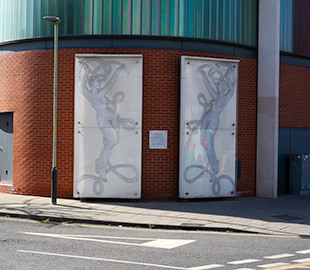
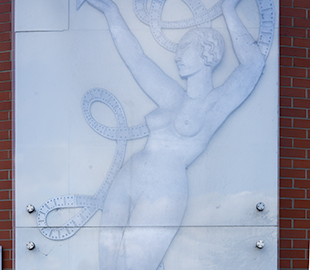
Barley
Entrances to the Brewery Quarter from St Margaret’s Road and Henrietta Street GL50 4FA
Sophie Marsham | 2006 | ///large.basis.lights & ///bleak.vase.props
As you enter the Brewery Quarter from either St Margaret’s Road or Henrietta Street, you will encounter three stainless steel poles. Look up, and you will see the copper ears of barley, harking back to the site’s history as Cheltenham’s largest brewery until 1998.
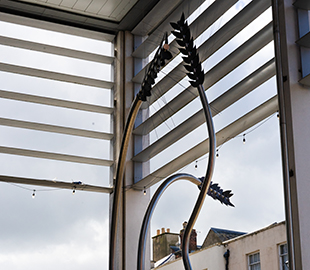
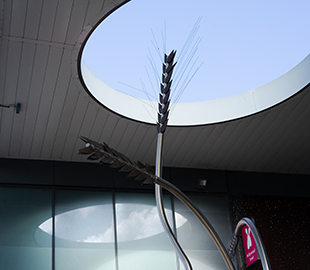
High Street
Centre Stone
Corner of High Street and Bennington Street GL50 3HH
Late 19th century | ///drives.crash.cups
Look up above F Hinds on the corner of the High Street and Bennington Street, and you will see a plaque marked Centre Stone on the corner of the building. This is close to the site of the old Market House from where all distances, including cab fares, were measured.
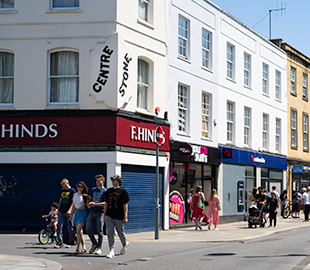
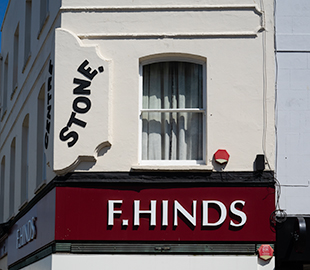
Boots Corner Fountain
Boots Corner at the junction of Clarence Street and Promenade with the High Street.
1938 | ///land.slurs.veal
Originally commissioned as the centrepiece for a new traffic island, Boots Corner fountain is now in a pedestrianised area, surrounded with seats and perennial planting. It is held in great public affection as a local landmark and popular meeting point.
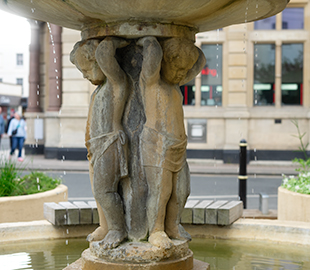
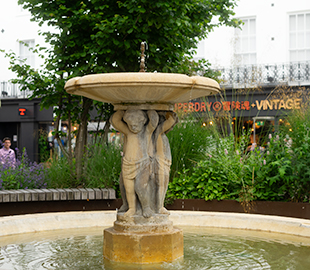
Elephant Mosaics (aka Errant Charges)
Grosvenor Place South, High Street end on the side of 103 High Street (Roxy Lanes) GL50 1DP
Nick Robertson & Tim Turton | 1938 | ///broker.snacks.front
These panels tell the true story of the day an elephant escaped from the circus parade in search of food in the pet supplies stores and the mayhem that ensued. Based on a 1934 local newspaper report, Cheltenham artists Nick Robertson and Tim Turton tell the story over 5 mosaic panels.
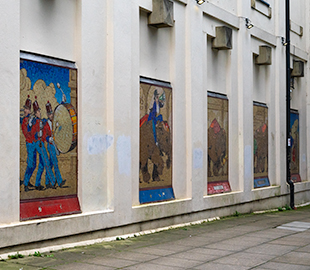
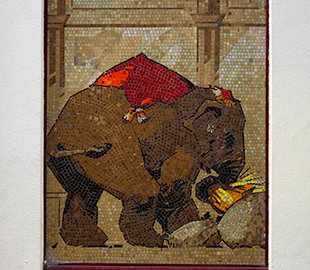
Regent Arcade
Wishing Fish Clock
Regent Arcade
Kit Williams & Matt Harding | 1987 | ///beside.dined.grow
The centre piece of the Regent Arcade, this 45-foot-high clock has a mechanism based on a goose continuously laying golden eggs. When the clock is working, the giant wishing fish at the base of the clock blows a stream of bubbles into the arcade every half hour, to the tune I’m forever blowing bubbles. Beloved by small children and their families who will wait at the base of the clock in anticipation.
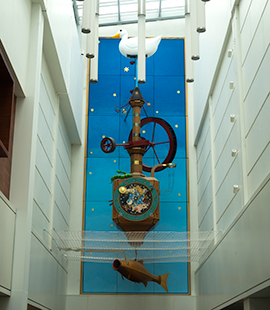
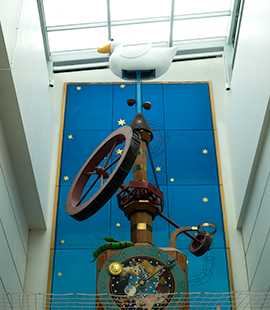
Clarence Street & Royal Well
Theme & Variations
Cheltenham House, Clarence Street GL50 3JQ
Dame Barbara Hepworth | 1970 - 72 | ///game.landed.closed
You will need to look up to see this magnificent sculpture by Barbara Hepworth. It is at first floor height above the entrance to Wagamama – which may be why it was included on a Hidden Cheltenham trail in 2018.
It was commissioned in 1970 for the Cheltenham & Gloucester Building Society’s new flagship headquarters. In October 2019, the artwork was listed by Historic England to prevent it being removed.
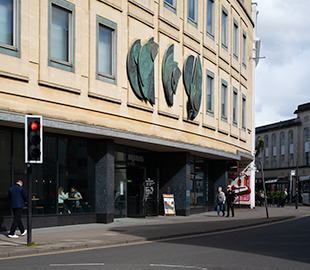
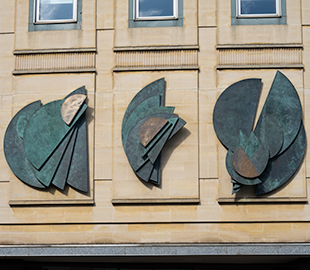
Sylphs with Trumpets
Bank House Wetherspoons, 15-17 Clarence Street GL50 3JL
Henry Graham Powell | 1957 - 1963 | ///string.item.emerge & ///scary.brands.groom
This pair of androgynous leaping sylphs representing ‘The Spirit of Youth’ were commissioned by Daniel Neal, a well-known children’s department store, between 1958 -63. They were made from fibreglass by Cheltenham architect, Henry Graham Powell. Originally white, they were painted gold in 2009 and it appears a small addition was made to the left-hand sylph at the same time.
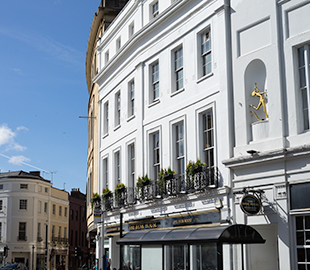
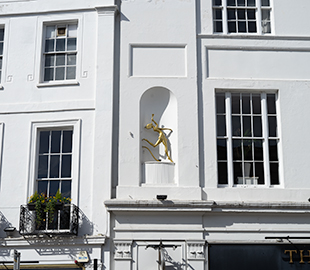
Shakespeare
On top of the the pediment above the entrance to Cheltenham Public Library, Clarence Street GL50 3JT
G Halling, R L Boulton & Sons Ltd | 1911 | ///brand.stump.slick
You will have to look up to spot this statue of Shakespeare, high above the entrance to Cheltenham’s Public Library. The statue was donated to the library from renowned local stonemasons R L Boulton & Sons in 1911.
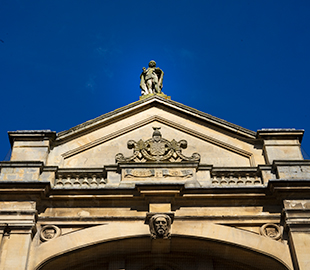
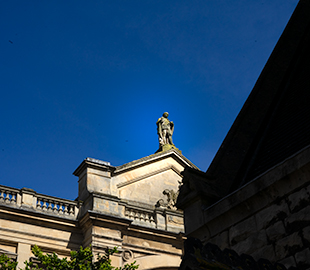
The Wilson Grille
The Wilson Art Gallery and Museum Clarence Street GL50 3JT
Alan Evans | 1991 | ///lands.split.basin
The decorative grille was commissioned by the Friends of Cheltenham Art Gallery & Museum (as it was then known) to go over the entrance to the museum’s extension, opened in 1989. Designed by artist blacksmith Alan Evans, it takes its inspiration from the museum’s arts and crafts collection, specifically from Ernest Gimson’s squirrel fire dogs.
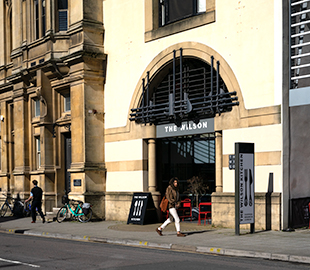
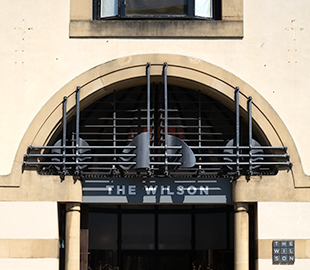
Smiths Clock
Royal Well, Cheltenham
Smiths Electric Clock and Watches Ltd | 1956 | ///comical.native.wrong
This tower clock was donated to Cheltenham as a town clock in 1956 by Smiths Clock and Watches Ltd. The former town clock in the High Street was beyond economic repair and had not been working for some time. The gift celebrated the business’s strong association with the town. Smiths had moved to Bishops Cleeve in 1940, and by 1956 they employed 2,500 people in Cheltenham, many of them in clock and watch making.
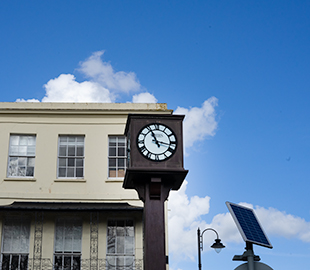
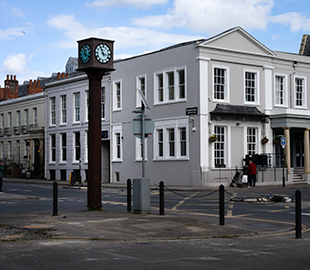
Phoenix
Royal Well, Cheltenham
Phoenix Assurance presented this phoenix plaque to Young & Gilling Estate Agents in 1946, in recognition of 110 years of representation. It was painted in vivid colours, with the phoenix rising from red, gold and white flames on a bed of black coals, but a recent coat of paint has rendered it gold all over.
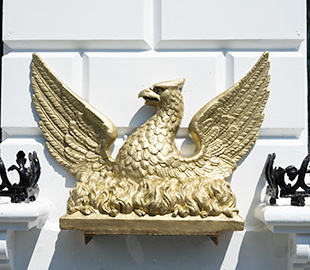
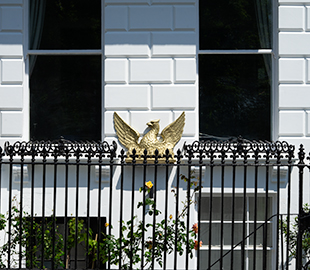
Promenade
Minotaur and Hare
The Promenade GL50 1HP
Sophie Ryder | 1995 | ///heavy.insist.snap
Originally part of a temporary exhibition of Sophie Ryder’s sculpture in 1997, the town was offered the opportunity to buy the Minotaur and Hare at the end of the show. The money was raised, and the Minotaur and Hare have enjoyed their seat in the Promenade ever since.
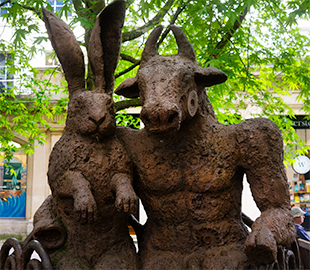
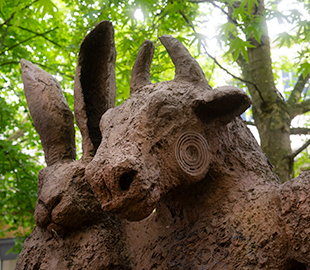
Phone Boxes
The Promenade GL50 1HP
1935 | ///rock.truck.drip & ///count.orders.start
The ten red phone boxes on the Promenade have not been used for making calls since they were decommissioned and refurbished in 2014. Now they are used as temporary exhibition spaces by the Cheltenham Trust, as well as providing a power supply for the many markets held on the Promenade.
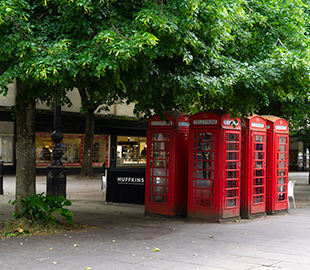
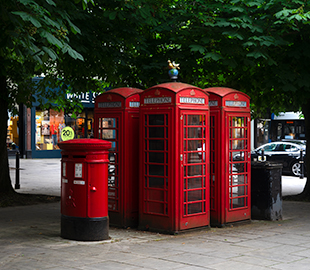
Pigeon Trail
Town Centre, on pedestrian area of the Promenade and outside Primark
Beth Forrester, Susan Early, Rachael Thorogood, Joy Parker | 2019
///leave.chimp.among ///drew.apron.scout ///rock.truck.drip ///count.orders.start
In 2019, artists and craftspeople were asked to decorate cast iron pigeons to create a trail around town. There were originally 10 pigeons but now only 4 remain. See if you can spot them on the Promenade and at Boots corner. Look on the top of signs and phone boxes.
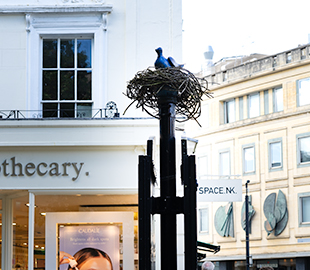
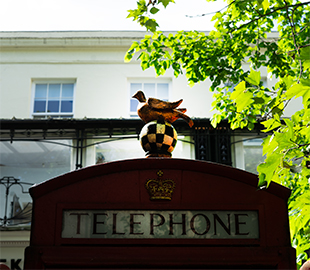
Long Gardens
The Neptune Fountain
The Promenade on the corner with St George’s Road
R L Boulton & Joseph Hall | 1893 | ///parent.tags.allows
Said to be inspired by Rome’s Trevi Fountain, the Neptune Fountain is one of Cheltenham’s landmarks. It was designed by Joseph Hall, Borough Engineer, who also designed the dragon and onion lamps and the Strozzi Palace substation.
In the summer months when the fountain is turned on, this is the only glimpse we get of the River Chelt as it travels through the town centre.
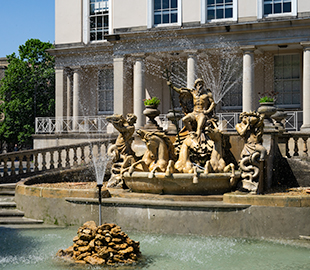
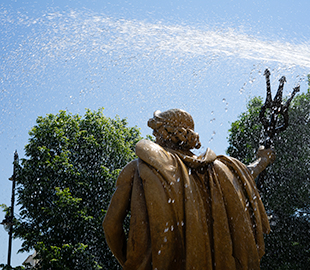
Edward Wilson
The Long Gardens, The Promenade GL50 1HZ
Kathleen Scott and R L Boulton & Sons Ltd | 1914 | ///doing.liked.pets
Commissioned by the Mayor of Cheltenham to commemorate Edward Wilson, who died in 1912 during Captain Scott’s doomed expedition to the South Pole. Cheltenham born and bred, Wilson was the party’s medic, zoologist and artist.
The sculptor was Lady Kathleen Scott, Scott’s widow, who also knew Wilson well. Wilson is depicted in his polar expedition clothes, complete with an extra pocket on the front for his sketch book. His outfit and pose may be familiar from photos held in The Wilson collection.
This was the first of what were to be many memorials to Scott’s Antarctic expedition.
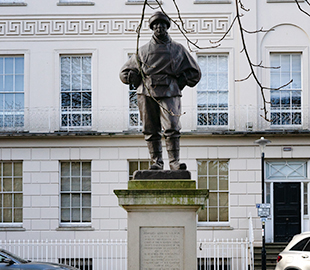
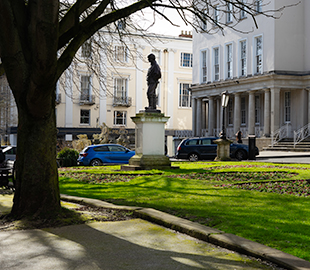
Boer War Memorial
The Long Gardens, The Promenade Gl50 1PJ
Ambrose Neal and R L Boulton & Sons Ltd | 1907 | ///logic.banks.native
A memorial to those lost in the Boer War, this statue was unveiled on 17 July 1907 by General Sir Ian Hamilton, some 5 years after the war ended in 1902. The soldier is modelled on one of the private soldiers named on the plinth.
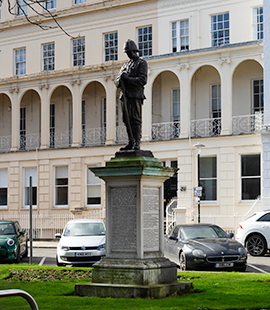
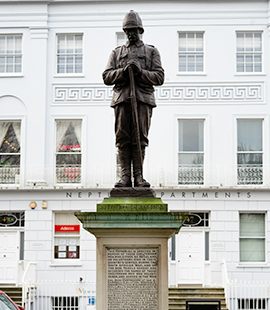
Imperial Gardens
Holst Statue
Imperial Gardens, GL50 1QA
Anthony Stones | 2008 | ///danger.banks.heave
Gustav Holst, composer of The Planets, stands arms aloft and ready to conduct an orchestra. The statue is close to the Town Hall where his work has often been performed, as well as the former Winter Gardens where both he and this father will have performed.
Each of the seven planets are depicted on a bronze panel on the plinth.
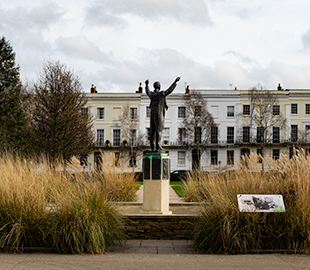
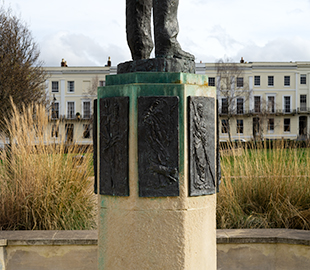
Imperial Fountain / Napoleon Fountain
The Broad Walk, Imperial Square GL50 1QG
Late 18th Century | ///kick.music.stick
This ornate marble fountain may look like it has always been here, but the Regency style terrace was only built in the late 1990s.
The fountain has had a colourful history, having been looted from Italy by Napoleon’s army, then captured from the French by privateers, finally ending up in Cheltenham in 1826. Since then, it has had many homes including: Montpellier Gardens; the Town Hall; the foyer of the Central Library; and the Lloyds Bank which then occupied the Rotunda building.
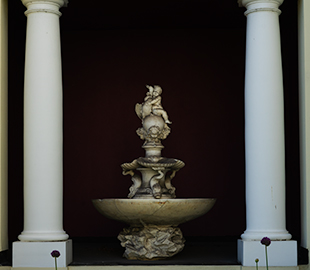
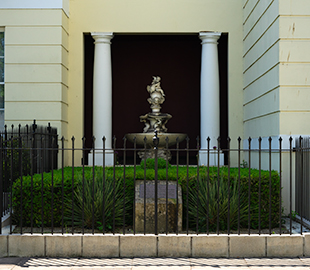
Crimean War Memorial
In front of the Queens Hotel, on a traffic island bounded by The Promenade and Imperial Square
Butts Foundry, Gloucester | 1858 | ///slave.wasp.shut
This cast iron base was built to display a Russian cannon captured at Sebastopol as a memorial to those lost in the Crimean War. It was originally one of a pair. The other base and both cannon were donated to the war effort in 1942 along with much of Cheltenham’s ornamental ironwork.
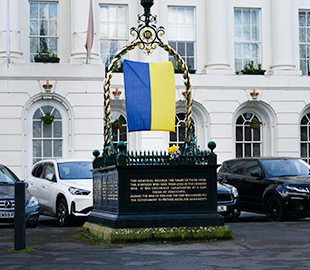
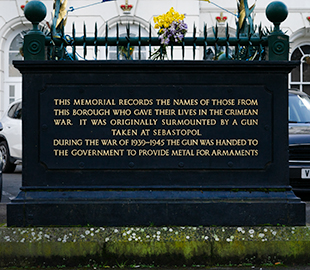
Montpellier Gardens
William IV
East end of Central Walk, Montpellier Gardens
William M Gardner | 1831 | ///trap.heavy.years
This is one of only a few statues of William IV; another is in Cheltenham’s twin town Göttingen in Germany. It was erected in Imperial Gardens to mark the King’s coronation in 1831, then moved to its present site in 1920.
William IV’s reign oversaw the 1832 Great Reform Act, which gave Cheltenham its own MP for the first time.
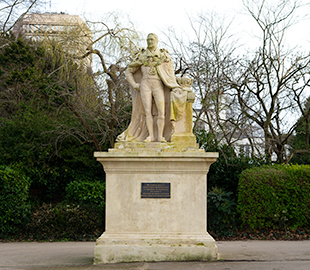
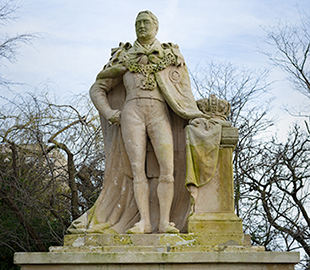
Jubilee Seat
Montpellier Gardens, GL50 1UL
David John & Oliver Budd | 2003 | ///bubble.hidden.priced
Commissioned by Cheltenham Arts Council to commemorate Queen Elizabeth II’s Golden Jubilee. A five sided seat, each side representing a decade of her reign. The golden notes play God Save the Queen. It is topped with a pigeon which links to both the discovery of Cheltenham’s spa waters and the Queen’s presidency of the Royal Pigeon Racing Association, then based in Cheltenham.
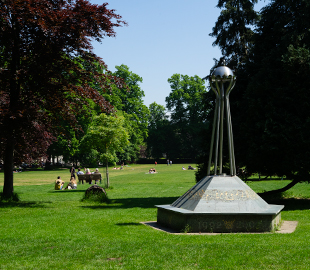
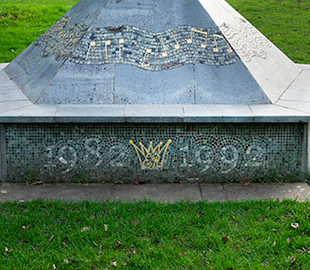
Playground Lion
Outside the children’s play area in Montpellier Gardens
This modest lion couchant echoes the more impressive lion looking across Montpellier Gardens from above The Ivy. Presented by Cheltenham Lions Club to accompany their donation of the playground, the lion was originally inside the playground. It has been moved outside the playground for health and safety reasons, and no doubt to protect the lion from the wear and tear of being ridden by small children.
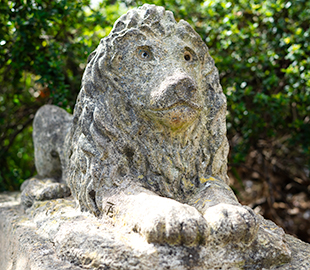
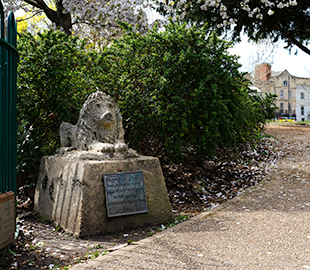
Montpellier & Bayshill
Rotunda Lion
On top of the parapet above entrance to The Ivy, Montpellier Walk GL50 1SD
George Allen Underwood (architect) | 1817 | ///chats.bottom.wizard
This imperious lion couchant looks over from the parapet of The Ivy to Montpellier Gardens. He is dwarfed, however, by the magnificent rotunda dome behind him. The rotunda was a later addition to the then Montpellier Pump Room in 1826. It was modelled on The Pantheon, Rome, and is even more impressive when viewed from inside the building.
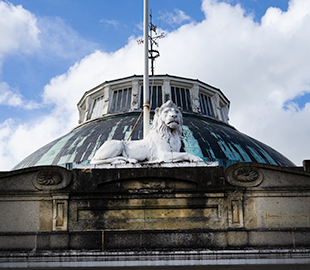

Caryatids
Hanover House and 1 - 23 Montpellier Walk GL50 1SD
John & William Brown and others | 1840s - 1850s | ///lodge.cook.cape to ///groups.dangerously.puts
The 32 white caryatids, or ‘armless ladies’ are a distinctive feature of Montpellier. The three original terracotta caryatids were brought back from London to be used as pillars between the shop fronts of the new fashionable shopping area. As more shops were built along Montpellier Walk in the 1840s and 50s, copies were commissioned from local sculptors to continue the row.
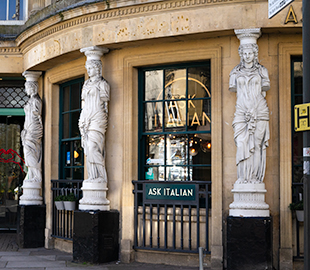
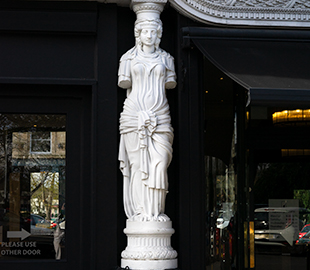
Edward VII
Central reservation of Montpellier Walk, on the approach to the roundabout
Ambrose Neale, R L Bourton & Sons Ltd | 1914 | ///rinse.learns.bucket
This statue of Edward VII, wearing a Norfolk suit, portrays him as the Spirit of Peace leading the Spirit of Mischief (the ragged female wraif) to the peaceful waters. It was commissioned by Mr & Mrs Drew of Hatherley Court in memory of the King, and as a drinking fountain with separate troughs for horses and dogs.
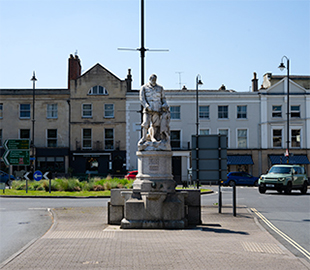
.jpg)
The Gordon Lamp
Lansdown Road, between the junctions with Parabola Road and Lypiatt Road
1887 | ///posts.foam.hiking
An ornamental lamp named to honour General Gordon, a nineteenth century military hero who died in 1885 at the Siege of Khartoum. Like many of Cheltenham’s ornamental lamps, it was a popular meeting place until the volume of traffic made this difficult.
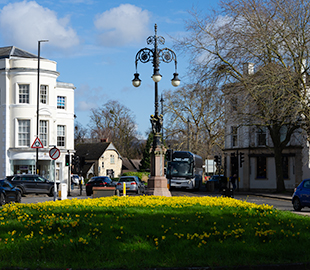
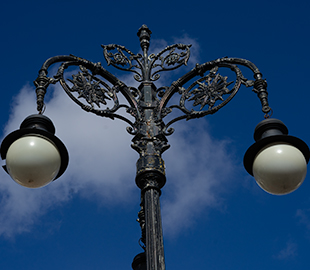
Poppy
In the garden of Malmaison Cheltenham, Bayshill Road GL50 3AS
Peter Fillingham | 2013/14 | ///nurse.proper.middle
A colourful glass cube on a stone plinth in the garden of the Malmaison Hotel, this sculpture was commissioned as part of a larger collection of contemporary art for a boutique hotel. The rest of the collection, including 160 pieces curated by Central St Martins College of Art and Design, can be seen inside the hotel.
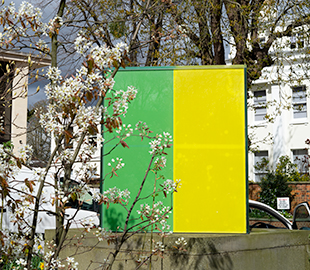
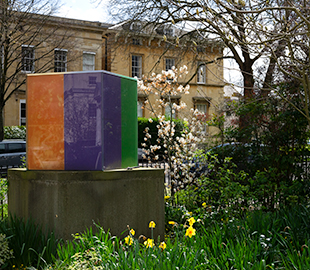
One Bayshill Bench
Outside 1 Bayshill Road GL50 3FH
Lindsey Mendick | 2019 | ///remind.sticky.editor
This bench in front of One Bayshill Road is a piece of art commissioned by Pegasus Life for both residents of One Bayshill and the general public to enjoy. The 600 tiles which decorate the bench were painted by artist Lindsey Mendick and members of the public at drop-in workshops held across Cheltenham.
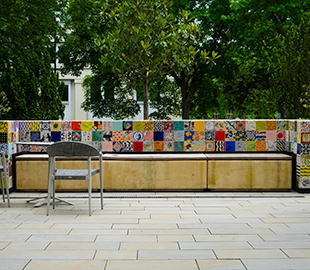
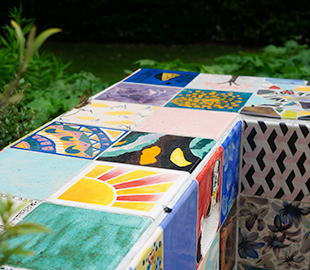
Honeybourne
The Great Oolite
Honeybourne Place, Jessop Avenue GL50 3SH
Nika Neelova & other contributors | 2021 | ///truly.super.then
A visual interpretation of the geological strata in the Cotswold escarpment and how it has influenced Cheltenham’s landscape. Nika Neelova collected rocks, and soil from the disused quarries in Leckhampton to study. She then broke them down and cast the dust in Jesmonite to create the individual brick slips, which were then applied to the façade of the building.
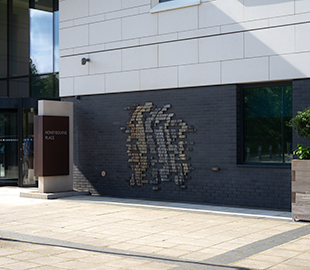
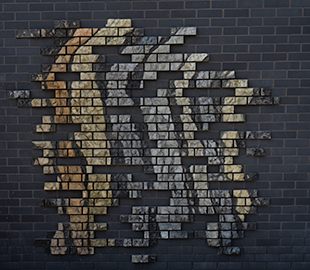
Jessops Gardens
Millbrook Roundabout, Honeybourne Way
Andrew Stonyer | 2009 | ///leave.eggs.bring
The name and the inspiration for this sculpture came from Jessops Gardens, a nursery and pleasure gardens which extended over a large area near here from the 1820s until it was destroyed by flooding in 1855. The bright colours of the painted steel represent the exotic fruits and plants.
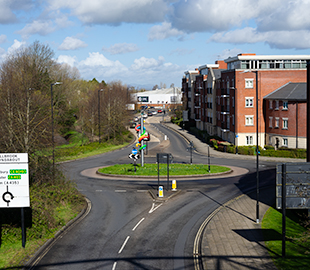
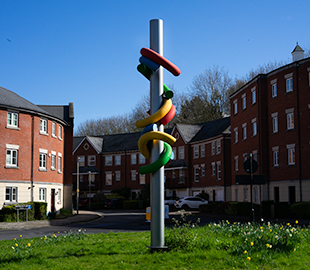
Winston Churchill Memorial Garden paths
Winston Churchill Memorial Garden, GL50 3HU
Emily Lawlor | 2001 | ///cakes.statue.crisp
The paths into the centre of the formal garden are made up of bricks beautifully etched with verse, patterns, leaves and reminiscences. These were reclaimed from an installation made by Emily Lawlor working with community groups and school children. The original work also incorporated darker bricks laid out as railway tracks, the colours echoing the retaining walls of the Honeybourne Line.
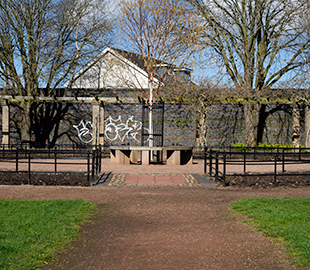
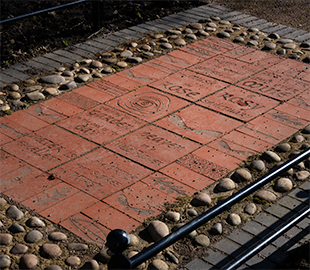
Sandford Park
The Friendship Circle
Sandford Park, at the crossroads of paths coming from Bath Road, St Lukes Place, High St & College Road
Neville Gabie | 1993 | ///field.burn.tonic
The Friendship Circle marks a meeting space at the intersection of paths, representing Cheltenham’s relationships with its twin towns across the world. This part of Sandford Park was laid out with dedicated areas for each of its twin towns. This was an early career work by internationally recognised artist, Neville Gabie.
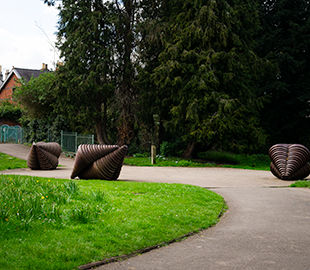
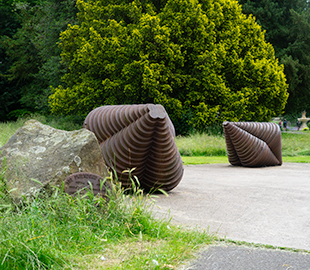
The Unwin Fountain
Sandford Park west side, near College Road entrance
Gilbert Boulton RCA | 1928 | ///kicked.range.finely
This attractive fountain was installed in the newly opened Sandford Park in 1928. It was a donation from the Unwin family in memory of Herbert Unwin of Arle Court.
The surrounding flower beds were one of the first Cheltenham park sites to be converted from annual bedding to sustainable perennial planting in 2019.
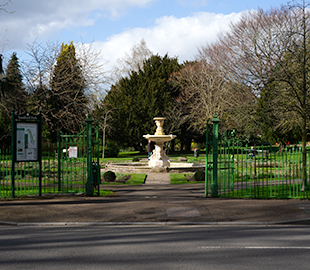
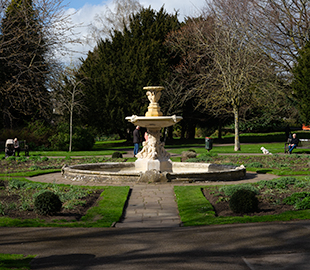
The Weathered Man
Sandford Park to the east of College Road
James Gould | 2006 | ///digits.simply.asking
A piece of public art commissioned to cover a drainage culvert as part of a flood alleviation scheme. The bronze statue is a roughly formed man lying on his stomach. He is supposedly watching the waters below, but is believed by many to be looking over towards the play area.
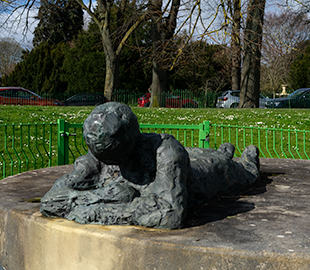
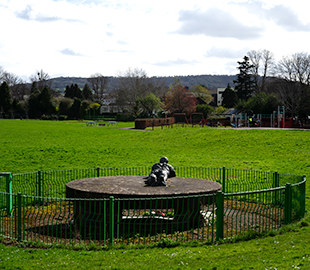
The Whish Sisters' Fountain
The Linc Garden, Sandford Park, near Keynsham Road
A.B. Wall | 1891 | ///signal.shut.curl
Donated by the three Whish sisters to the town in 1891 to celebrate their 50 years as residents of Cheltenham. The fountain was originally in Westall Green, but was moved to Sandford Park in 1929. Somewhere along the way, it lost its basin and weathervane, and although it no longer has a water supply, it is still known as a fountain.
It is surrounded by the LINC Sanctuary Garden, planted in 2019.
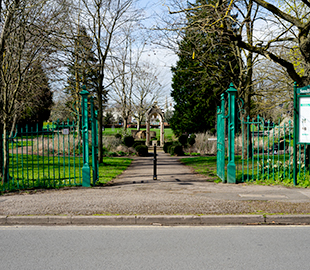
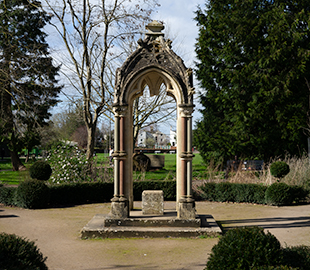
Cheltenham General Hospital
Florence Lamp
Entrance to the Central Block, Cheltenham General Hospital, Sandford Road GL53 7AN
Alan Evans & Simon Hunter | 2000 | ///runner.post.vivid
An ornamental lamp and handrail by local artist blacksmith, Alan Evans, who gave his services free of charge in gratitude for the care his father had received while at patient at Cheltenham General Hospital.
.jpg)
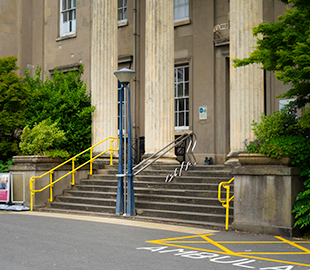
Dandelions
Commemorative garden outside Cheltenham General Hospital Pathology Department, College Road GL53 7HX
Jackie Lantelli | 2021 | ///every.puts.strict and ///intent.glad.manual
Dandelions took on a special significance for hospital staff and patients during the 2020 pandemic. In 2021, artists Jackie Lantelli and Sadie Kitchen made 1000 wire dandelions for a temporary installation in the hospital gardens. People were invited to sponsor a dandelion to raise money to improve this commemorative garden at Cheltenham General Hospital and create a new garden at Gloucester Royal.
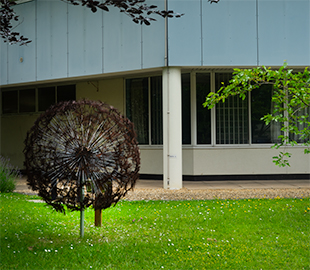
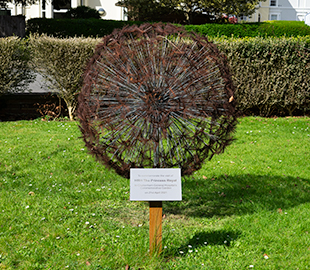
Mosaic Planter
Commemorative garden outside Cheltenham General Hospital Pathology Department, College Road GL53 7HX
Emily Lawlor and Star Centre students | 2002 | ///total.treat.hears
This was originally designed as a water feature, but it has been successfully converted into a planter. The designs on the ceramic tiles and surrounding paving stones by Emily Lawlor and Star Centre students are inspired by the work of the neighbouring Pathology department.
This is one of five mosaic projects around Cheltenham instigated by the Cheltenham Arts Council at the start of the millennium.
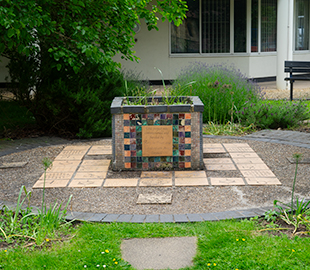
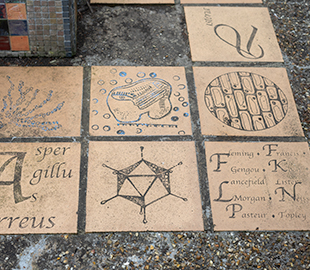
Pittville
Man and Ball
Sheldons Court, off Winchcombe Street GL52 2NR
Giles Penny | 2000 | ///clouds.public.hotel
Giles Penney’s life-sized simplified figurative forms are popular as public art. Is the man labouring under the weight of the ball? His face gives little away, allowing us to project our own feelings and interpretations onto him.
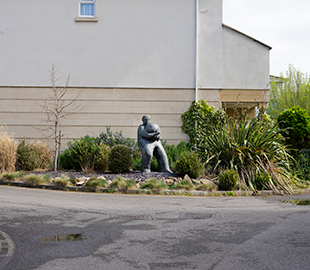
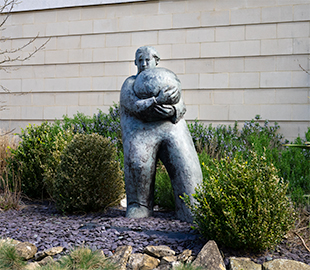
Pittville Gates
The southern end of Pittville Lawn
Robert Stokes | 1833 | ///serves.poker.native
Pittville Gates were built as the grand entrance to the Pittville Estate. They were restored to their current glory following an intensive period of historical research and fundraising by the Friends of Pittville. This included setting up a local history group, Pittville History Works, and landscaping the surrounding area. The restoration was completed in 2015.
Interpretation boards nearby tell the stories of the gates and Pittville Estate.
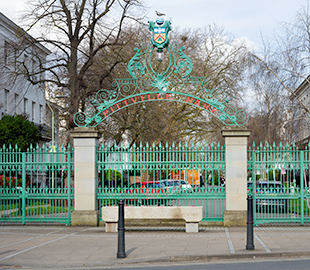
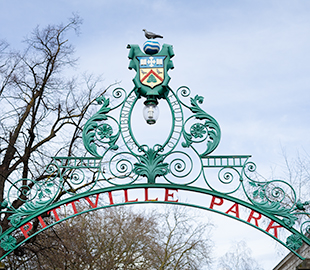
The Golden Boy
Laurie Lee Building, Pittville Student Village, Albert Road Gl52 3JG
Maurice Juggins | 2005 | ///sock.behave.fleet
The Golden Boy bust of Brian Jones, founding member of the Rolling Stones, is available to view in the Laurie Lee reception building at Pittville Student Village between 8:00 - 17:00 Monday - Friday.
Brian Jones grew up in Cheltenham, before moving to London as a teenager to pursue his music career. He was buried in Cheltenham Cemetery following his death aged only 27.
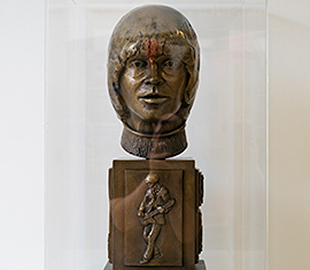
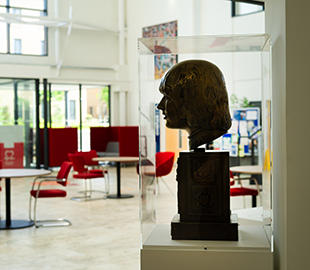
Nest for Pittville
Pittville Student Village, Albert Road, Cheltenham, GL52 3JG
Rich White | 2017 | ///dips.exit.incomes
Before re-opening as a student village in 2017, Pittville campus had housed the university’s art departments for several decades. A competition was held for former students to submit proposals for a sculpture for the new development, and this was the winning entry.
The Nest represents the campus as a nurturing space. Students and visitors are welcome to sit inside it.
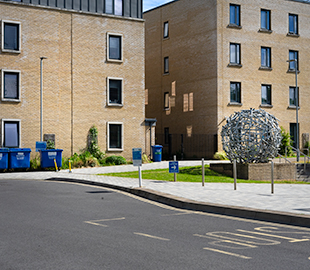
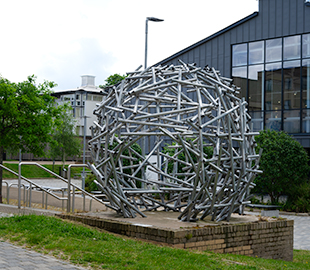
Pittville Community Bridge
Across the lower lake in Pittville Park
Christopher Lisney | 2012 | ///clash.note.hype
The bridge spans the boating lake in Pittville Park. It is made of galvanised steel for strength and resilience, but with decorative elements including the bulrush forms at either end and relief panels along either side of the bridge. The images come from children at Dunalley and Pittville schools, and other park users, and depict many of the things you can do in the park.
Look under the bridge to spot the bird and squirrel.
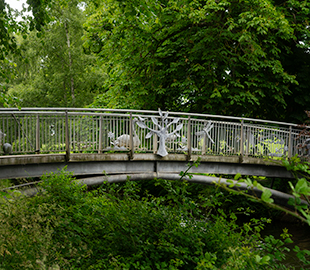
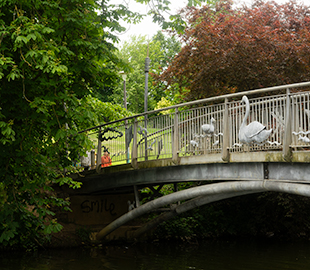
Pittville Pump Room Statues
On top of the parapet of Pittville Pump Room, East Approach Drive GL52 3JE
Patrick Conoley, R L Boulton & Sons Ltd | 1965 | ///souk.danger.spot
Statues of (from left to right) Asclepius with a wooden club, Hygeia with a serpent and a bowl of water, and Hippocrates with a serpent and staff. These were. carved in 1965 by Patrick Conoley for the recently restored Pump Room. The original statues from 1827 had been in storage for 25 years and were so damaged that Conoley could not copy them, and had to produce his own interpretations.
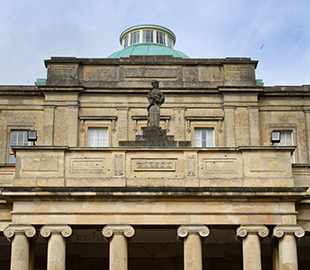
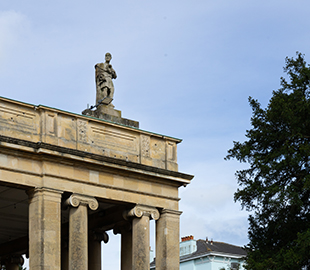
Wellington, Clarence Square & St Paul's
Tree Sculpture
South-west corner of Clarence Square, near the entrance to the garden
Lee Dickinson aka Squashedapple Woodcarving | 2005 | ///rooms.civic.parts
A chainsaw sculpture, carved out of a dying yew tree. The sculptor Lee Dickenson, aka Squashedapple Wood Carving, has fashioned abstract forms from the healthy parts of the tree. Some people see a duck, others a dolphin. What do you see?
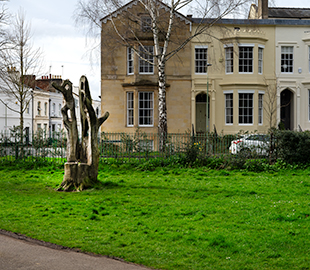
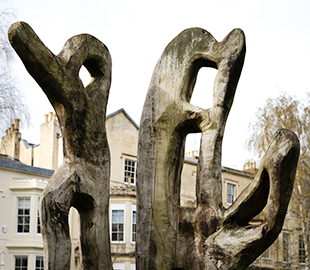
St Paul's Narrative Planter
St Paul’s Road, on the pavement outside the School House Café GL50 4EZ
Matthew West | 2017 | ///tuck.data.bucks
A large, galvanised steel planter in the heart of St Paul’s, on the pavement outside the Schoolhouse Café on St Paul’s Road. It is covered in relief images and text based on stories gathered from the St Paul’s community during 2015-16, including personal recollections and local history.
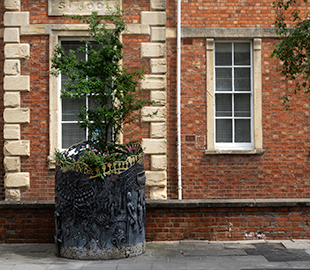
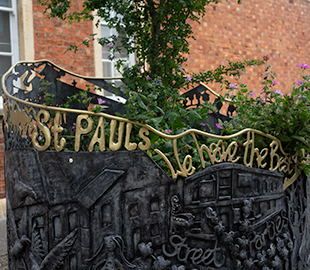
Unicycling Robot
53 Swindon Road, GL50 4AH. On the corner of Swindon Road and St Paul’s Street North at first floor height
Rust Bucket Workshop aka Hayley Walker | 2022 | ///slide.maker.dock
This charming, juggling robot was created for the 2022 Cheltenham Paint Festival, and designed especially to fit into the blank first floor window recess. Rust Bucket Workshop is a Stroud based artist who creates 3D artworks using discarded objects. A closer look reveals a bicycle wheel, funnel and cans.
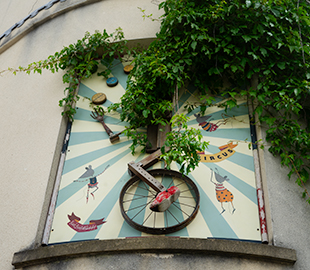
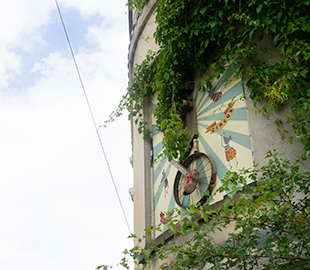
Hamlet
Second floor niche between 6 and 7 Wellington Square GL50 4JU
Late 19th Century| ///gates.stow.coffee
Look up to the second floor of the central houses of this terrace, in the niche between numbers 6 and 7, and you will spot a statue of a man in Elizabethan clothing. From 1860-1873, 6 Wellington Square was the home to William Macready, renowned 19th century Shakespearean actor. The statue is believed to depict him as Hamlet.
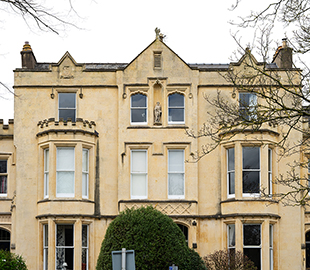
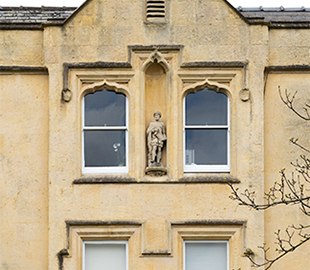
South Town
Bath Road Utility Boxes
Along the Bath Road from the Norwood roundabout to the junction with the A40, Suffolk Road
Rhys Cowe and Chantal Freeman | 2014 - ongoing | ///scared.mile.deaf to ///film.tides.object
An initiative by the residents’ and traders’ associations to brighten up and give a visual identity to the Bath Road shopping area. The stencil designs on the utility boxes use repeated motifs taken from Victorian tiles in the butchers, grapes in the church’s stained-glass windows and the cedar trees growing by Cheltenham College. Initially there were 19 boxes, but the utility companies keep adding more, and Rhys keeps coming back to paint them.
This has inspired similar projects elsewhere including in the town centre.
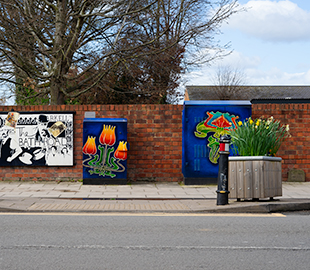
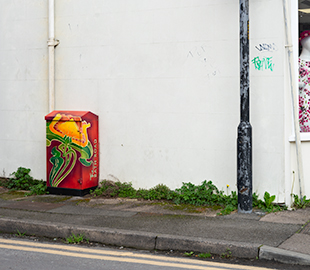
Bath Road Trading
On the wall outside The Exmouth Arms, Bath Road GL53 7LX
Sue Brown and Rachel Davis | 2013 | ///harsh.area.basket
A large enamel panel made up of images depicting 200 years of trade on the Bath Road, a popular local shopping area.
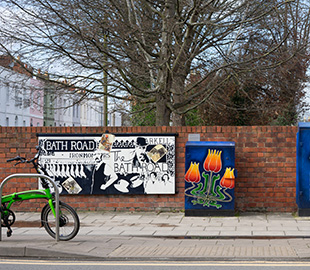
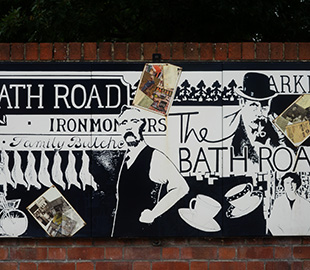
Norwood Triangle
At the intersection of Grafton Road, Norwood Road
Malcolm Martin and Gaynor Dowling | 2010 | ///busy.truth.cake
The Norwood Triangle was created as a green community space in a densely built-up area. The artwork created by artists Martin and Dowling with children from local primary schools was one part of the project along with trees, plants, lighting and seating. The stone and bronze plaques set into the ground illustrate the history of the tramroad and associated industry in Leckhampton.
.jpg)
.jpg)
Rotating Form
University of Gloucestershire, Park Campus
Andrew Stonyer | 1995 | ///below.rungs.token
Commissioned by the University from their Professor of Fine Art, Andrew Stonyer. In lieu of a fee for his work, the University agreed to fund a bursary for a PhD student.
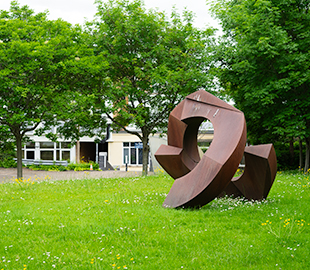
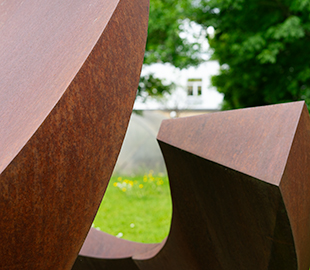
Tivoli Lamp
Andover Road, on a traffic island at the junction of Andover Road and Suffolk Road
Late 19th Century | ///panels.added.under
An attractive, ornamental lamp incorporating seats at the base, across the road from the Tivoli shopping area. This lamp was moved to Tivoli from Montpellier to make way for the Edward VII statue.
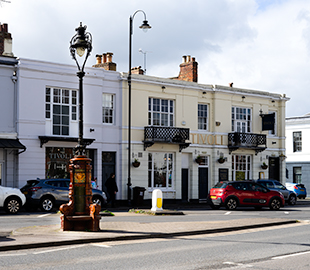
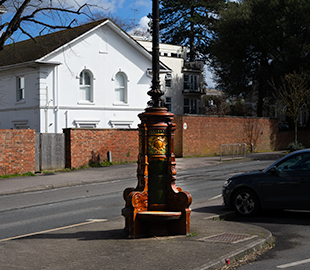
Up Hatherley
Flow
Humpty Dumps Playground, Reddings Road
Erick Klein Velderman | 2018 | ///means.bucket.agreed
Curved cor-ten and steel panels with cut outs evoking aspects of Cheltenham’s past and present including the spa and parks. This sculpture was originally designed as a centrepiece for the Benhall roundabout to welcome visitors to Cheltenham. Highways’ concerns about visibility led to it being redesigned and relocated to this small public greenspace on Reddings Road.
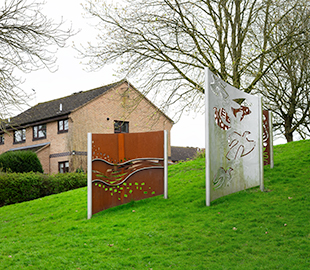
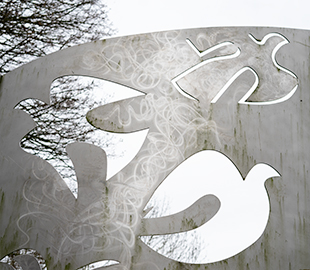
Babies & Bicycles
Entrance to Chapman Way from Alma Road
Charles Dorman, Lion Foundry | ///full.final.report & ///food.coast.lied
Two black cast iron panels either side of the entrance to Chapman Way, depicting babies working in a bicycle factory. The scenes are identical to the bronze plaques on the former Raleigh Cycles HQ in Nottingham.
The panels led to some speculation about where they had come from, and whether there was a Cheltenham connection. It turns out the developer found them in an architectural salvage yard and liked them, and there is no known local connection.
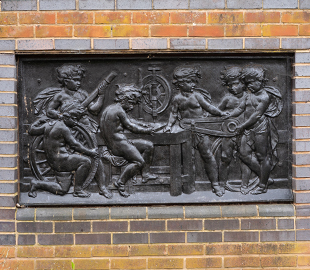
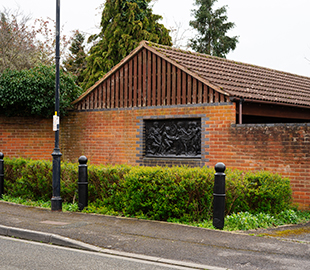
Carex, Bench, Arch
Hatherley Park, entrance from Hatherley Court Road
Dave Preston | 2011, 2017, 2019 | ///loads.scared.payer ///places.boat.legal ///valid.chief.global
Hatherley Park is fortunate in having a very active Friends group and a generous donor who have between them contributed to some lovely pieces of public art all by artist blacksmith Dave Preston. They include:
- carex grass sculpture by the pond (with additional danglers for special occasions;
- a circular seat at a high point of the park, with views to the Cotswold Escarpment as well as over the park;
- an arch over the entrance from Hatherley Court Road based on drawings by primary school children of what wildlife they expected to find in a park
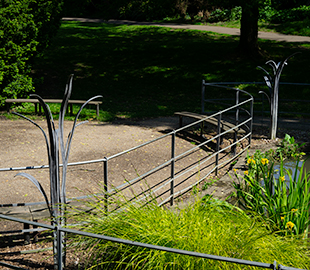
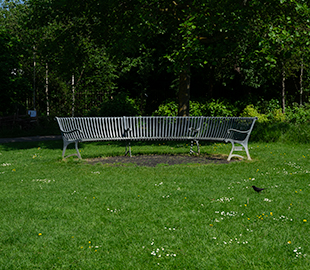
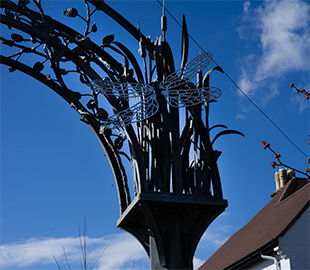
West Cheltenham
Listening Stones
Hesters Way Park aka Fishy Park
Gordon Young | 2004 | ///teams.battle.cure
Nine standing stones carved from glacial granite, commissioned by GCHQ.
The stones all represent different forms of communication, drawing on engagement with the local community. GCHQ employees contributed the cyphers on the stones leading to the Doughnut.
Part of the West Cheltenham Public Art Trail. https://westcheltenham.org/public-art-trail
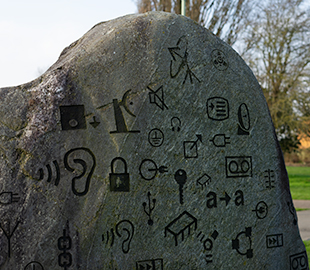
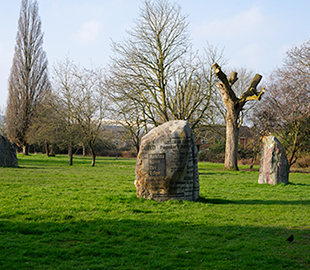
Hesters Way Mosaic Mural
On the wall of the Hesters Way Community Resource Centre, Princess Elizabeth Way GL51 7SJ
David Bowers and others | 2006 | ///folds.basin.exam
These mosaic panels tell some of the history of Hesters Way as interpreted by local community groups, working with mosaic artist David Bowers. They are on the wall of the Hesters Way Community Resource Centre which provides a local community hub. There were originally six mosaic panels, but only three now remain in situ.
Part of the West Cheltenham Public Art Trail. https://westcheltenham.org/public-art-trail
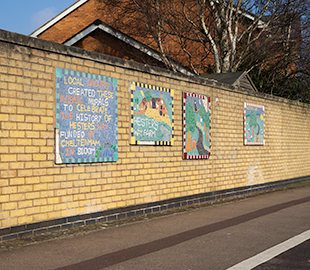
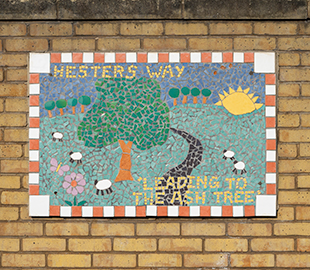
Story Chair
Hesters Way Library, Goldsmith Road GL51 7RT
Natasha Houseago | 2013 | ///moment.ashes.elder
The Story Chair was carved out of a single piece of ash in the library garden. Lots of groups of children visited to help Natasha to remove the bark and even to help with the carving. The finished chair is the perfect size and shape for a child to sit in and feel embraced by the chair, but still able to see out through the gaps beneath the arms.
Part of the West Cheltenham Public Art Trail. https://westcheltenham.org/public-art-trail
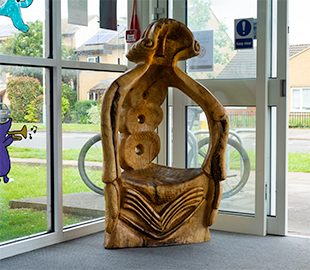
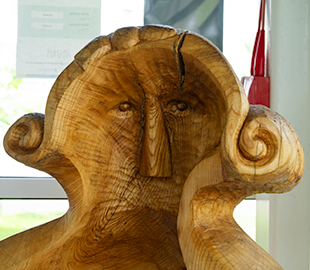
The Listening Dragon
King George V Park, Cheltenham
Rob Olins | 2019 | ///woods.begin.plus
Visit with a friend on a still day so you can try out the sound mirrors. These are based on an early warning defence system from the days before radar. Take turns speaking and listening into the concave concrete forms on either side of the path, following the instructions on the plaque.
The landscaping around the sound mirrors also provides a sheltered space to sit on what is otherwise a very exposed playing field.
Part of the West Cheltenham Public Art Trail. https://westcheltenham.org/public-art-trail
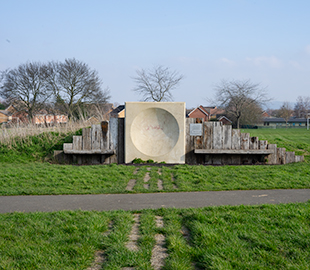
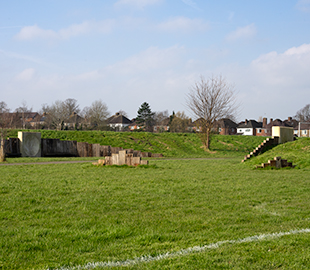
Spaceship Shelter & Totem
Springfield Park and Springfield Community Garden
John Easterby | 2007 | ///mixed.called.dive & ///speaks.loved.garden
The stainless-steel Spaceship Shelter is designed to look like a UFO landing in the park. It is a functional piece of artwork, providing somewhere for young people to hang out. Totem in the community garden is more organic in terms of its material and form.
Both artworks were commissioned as part of a large-scale regeneration and landscaping of Springfield Park in 2007.
Part of the West Cheltenham Public Art Trail. https://westcheltenham.org/public-art-trail
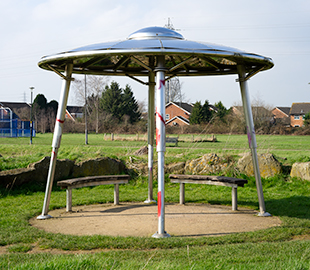
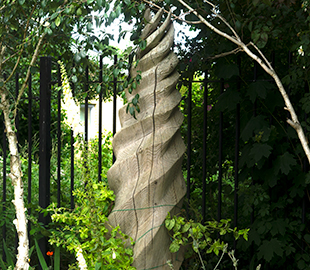
Swindon Village
Interactive Sundial
Playing field behind the Village Hall, Swindon Village, GL51 9QP
Andrew Higgins, Oliver Budd, Jay Alvarez, Emily Lawlor & Hugh Evans | 2004
Visit on a sunny summer’s day so you can try out the interactive sundial.
The sundial is laid out in the shape of St Lawrence’s Church tower. Set into this hexagonal base are mosaics by several different community groups: leaves by children at Swindon Village Primary School; birds by pupils at the Star Centre; etched bricks designed by the community; and larger mosaic roundels by Oliver Budd. This is very much a community led project built on years of engagement and fundraising.
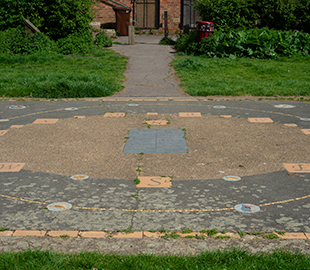
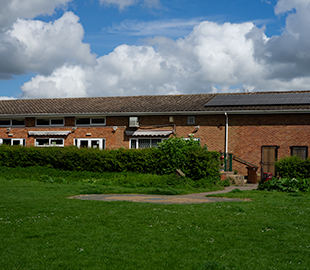
Drinking Trough
Outside Swindon Village Hall Church Street, GL51 9QP
1909 | ///casual.others.shot
This drinking trough used to be outside the Cross Hands on Tewkesbury Road, until road widening meant it had to be relocated to its current location.
Presented to the RSPCA in memory of Mr & Mrs Belcher of Swindon Hall. The upper trough is now used as a planter.
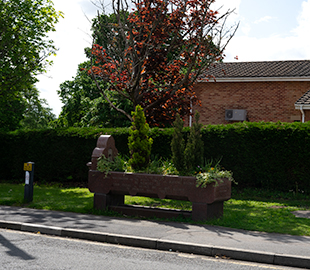
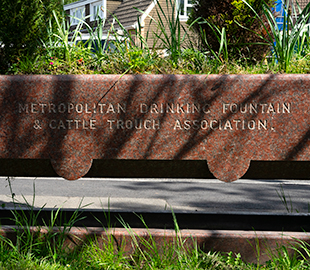
Windows
Community Rest Garden, Tewkesbury Road
Scott Farlow | 2016 | ///degree.tags.kind
Scott Farlow, was commissioned in 2016 as artist and project advisor to help bring the neglected and overgrown rest garden back into use. Working with community members, TCV and the council’s green space development team, the area was opened up, with little pockets dedicated to wildlife, gardening and community events. This art installation was part of that project. Since then, the garden has continued to develop as a haven for growing, biodiversity and creative activity.
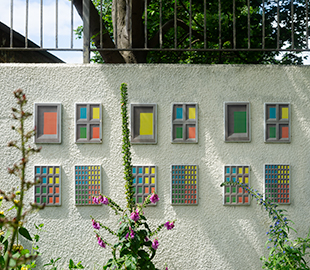
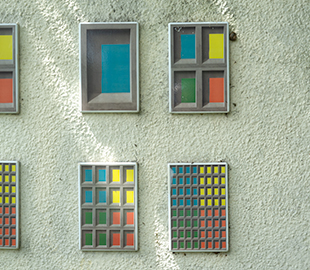
Cemetery
Wildlife Sculptures
Near Willow and Oak Chapels, Cheltenham Cemetery, Bouncers Lane GL52 5JT
Andrew Kay | 2019 | ///luxury.themes.struck
These beautiful woodland animals, sculpted from steel bars are as shy as their real-life counterparts. The deer, heron and pheasants blend in around the chapels of rest and at the edge of the cemetery. Their stillness provides an opportunity for contemplation, while not imposing themselves on mourners.
Charlton Kings
Mosaic Rill
Church Piece, Charlton Kings GL53 8AR
Oliver Budd | 2004 | ///frogs.update.brand
A man-made stream with a mosaic bottom, created as part of a £500,000 regeneration project for the centre of Charlton Kings. Mosaic artist, Oliver Budd’s design is based on ideas from workshops with children in neighbouring schools. At the bottom of this stream, you can spot all sorts of interesting objects, many of them with shiny elements. Much enjoyed by young children.
Stocks
New Street, Charlton Kings GL53 8JJ
Anthony Mustoe & Richard Ballinger | 1763 | ///taxi.many.dream
Charlton Kings’ original stocks, restored in 2015. There is an excellent interpretation board giving their history. It is not certain if these stocks have ever been used in punishment.
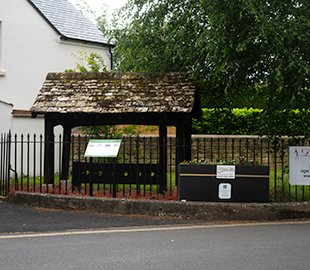
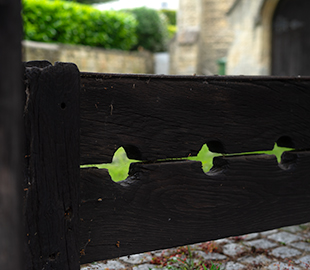
Lych Gate
North west entrance to St Mary’s Church Yard, Church Street, Charlton Kings GL53 8JJ
John Coates Carter and R L Boulton & Sons Ltd | 1920 | ///escape.caring.dangerously
The lych gate was erected by R W Boulton in thanks for peace and in memory of his father and nephew. His father, Richard Lockwood Boulton, was the founder of R L Boulton & Sons Ltd, the firm of sculptors and carvers based in Cheltenham from around 1870. The firm has contributed to much of Cheltenham’s public statuary, from the Neptune Fountain in 1893 to the Pittville Pump Room statues in 1965.
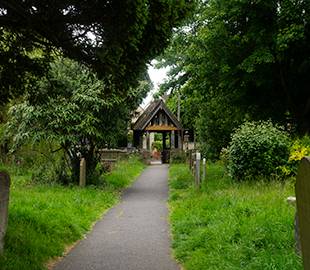
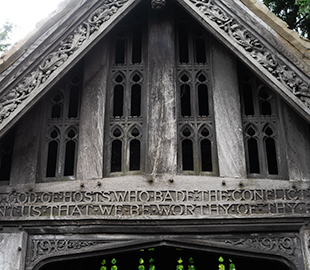
Drinking Fountain
Junction of London Road and Cirencester Road
John Middleton and R L Boulton & Sons Ltd | 1870 | ///loads.ladder.hungry
This ornate drinking fountain was commissioned and funded by local land and property owner, Charles Cooper Higgs, along with the adjacent Holy Apostles church and former school. Mr Higgs’ name lives on in the Higgs and Cooper Educational Charity which gives grants to young people in Charlton Kings for educational purposes.
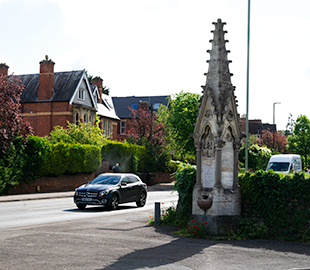
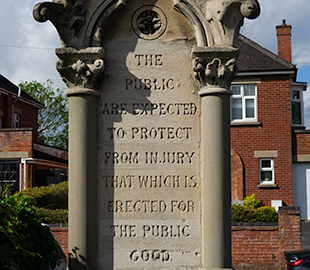



 to add an item to your itinerary basket.
to add an item to your itinerary basket.



.png)

